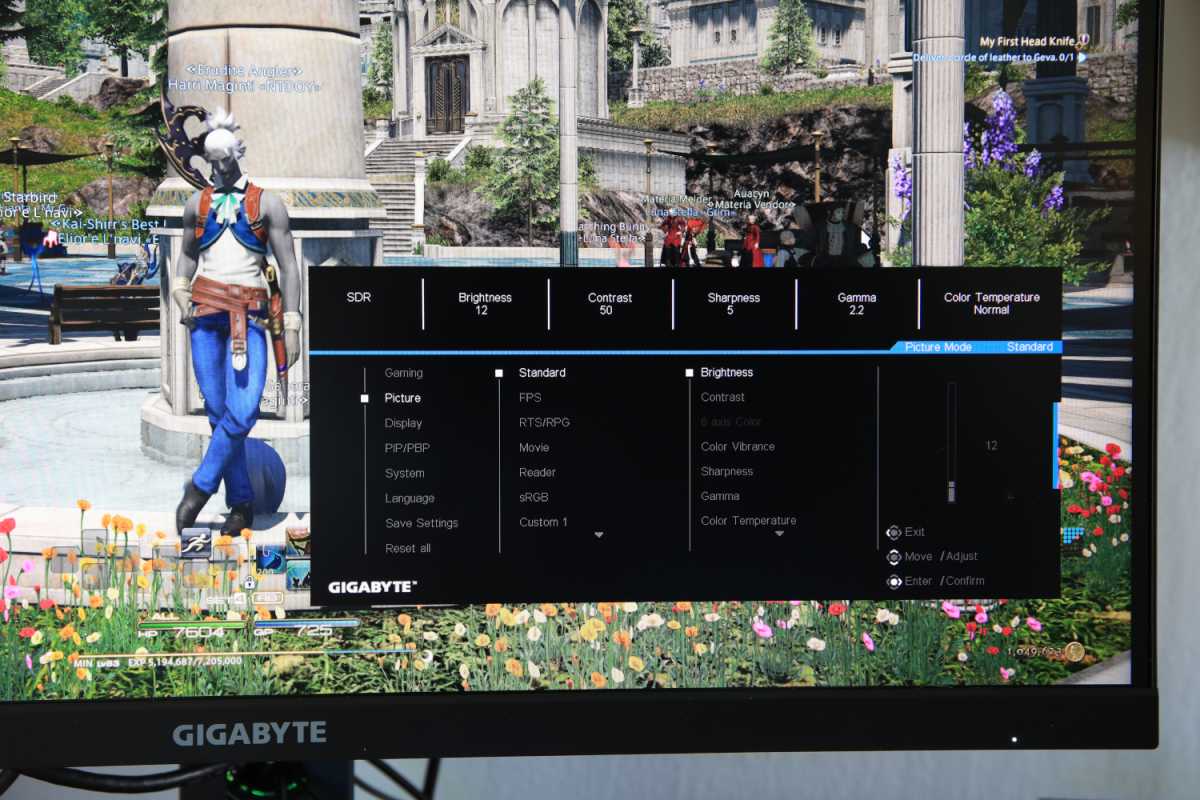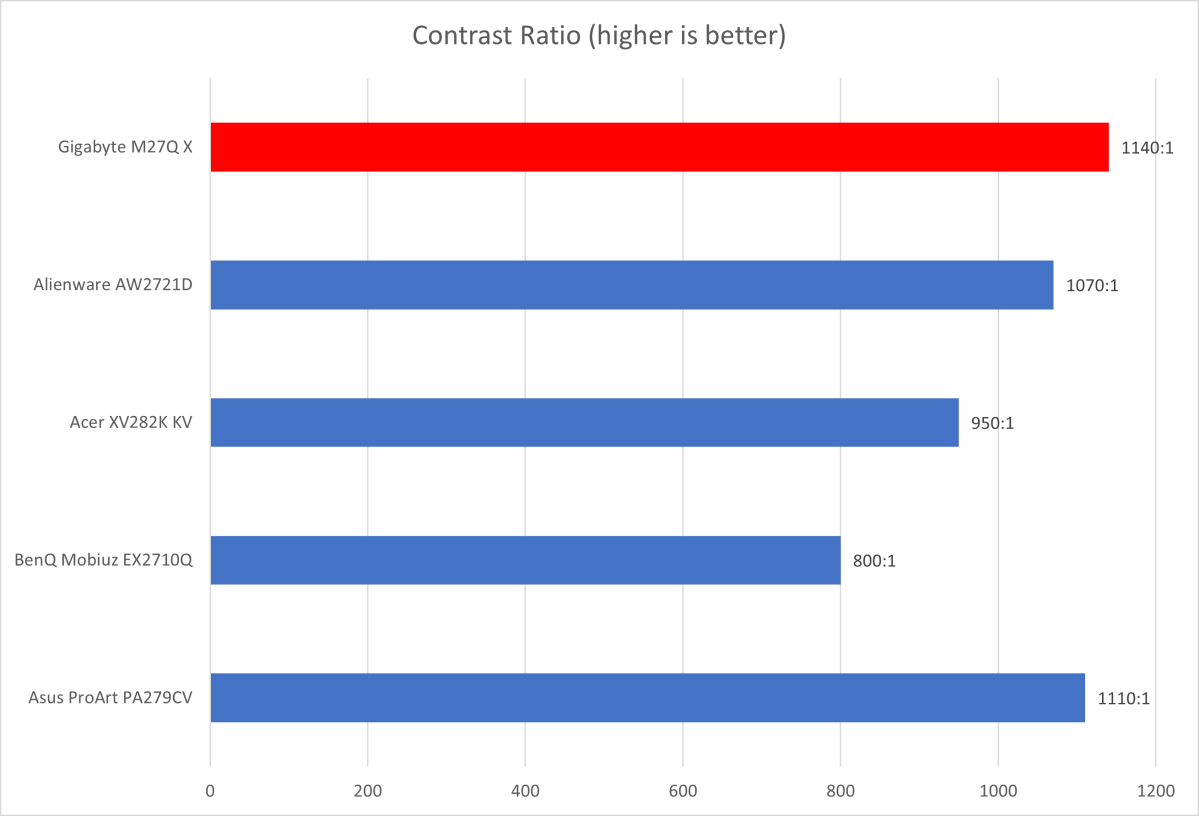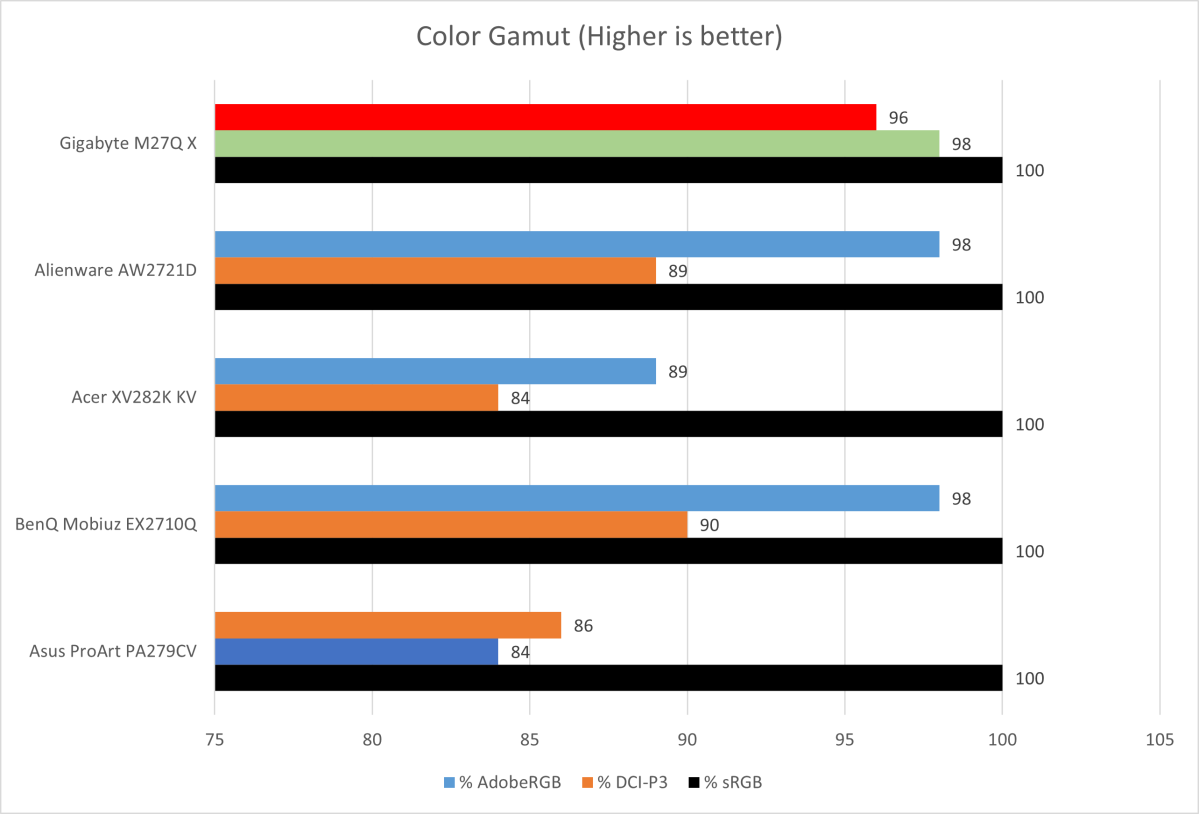Gigabyte M27Q X review: Lush color in a 240Hz monitor
Expert’s Rating
Pros
- Massive color gamut and great color accuracy
- Excellent motion clarity at 240Hz
- Value pricing for a 1440p 240Hz monitor
Cons
- Unimpressive build quality
- Stand only adjusts for height and tilt
- KVM feature is not impressive
Our Verdict
Gigabyte’s M27Q X doesn’t look like much out of the box, but this 1440p/240Hz IPS panel delivers a superb gaming experience where it counts, with excellent motion clarity and stunning image quality.
Best Prices Today: Gigabyte M27Q X

$664.99
There’s plenty of 27-inch gaming monitors to choose from, but one category remains slim: 27-inch displays with 1440p resolution and a 240Hz refresh rate. While roughly a dozen are now available, most are costly. The Gigabyte M27Q X tries to bring 1440p and 240Hz to a more palatable price.
Gigabyte M27Q X: The specs
Resolution and refresh rate are the headline features here, but a few others stand out. The monitor uses AMD FreeSync Premium Pro for adaptive sync and is not officially G-Sync compatible (though it did work with G-Sync in my testing). The monitor also supports HDR and is VESA DisplayHDR 400 certified.
- Display size: 27-inch
- Native resolution: 2560×1440
- Panel type: IPS edge-lit LED backlight
- Refresh rate: 240Hz
- Adaptive sync: AMD FreeSync Premium Pro
- Ports: 2x HDMI 2.0, 1x DisplayPort 1.4, 1x USB-C with DisplayPort Alternate Mode and Power Delivery up to 18 watts, 2x USB-A, 1x headphone
- Stand adjustment: Height, tilt
- VESA mount: Yes
- Speakers: 2-watt stereo speakers
- HDR: VESA DisplayHDR 400
- Price: $499.99
Carrying an MSRP of $499.99, and generally priced at or near its that price online, the Gigabyte M27Q X is not exactly affordable, but a good value for its feature set. Acer’s Nitro ED271U and Optix MAG274QRX are in the same price range, but premium alternatives like the Alienware AW2721D and Asus ROG Swift PG279QM are several hundred dollars more expensive.
Gigabyte M27Q X: Design
The M27Q X’s build quality falls firmly in budget territory. It has a simple, matte black plastic shell that seems thinner and more flexible than alternatives from Dell and BenQ, though it’s about on par with LG Ultragear monitors.
It’s not much to look at, either. The M27Q X doesn’t go for a bold gamer look, yet also doesn’t pass as a ho-hum home office monitor. Display bezels are of modest size on the top and sides, while the bottom has a small plastic chin. Around back the monitor is plain, with just a hint of plastic etching to set it apart.

Matt Smith / Foundry
The stand adjusts for height and tilt but doesn’t swivel and can’t pivot 90 degrees for use in portrait orientation. This is unusual for a 27-inch monitor that retails around $500, as most in that price range (and even lower) offer these features. A 100x100mm VESA mount is available for attaching a third-party monitor arm or stand with greater flexibility.
Gigabyte M27Q X: Features and menu
A buffet of image-quality options are packed in the Gigabyte M27Q X’s menus. These include precise gamma presets, several color temperature modes, and a dedicated sRGB mode, plus multiple gaming-centric options such as a black equalizer. The monitor’s numerous image-quality options will be useful to content creators who want to calibrate the display.
Accessing the options is a chore because of Gigabyte’s deep and confusing menu structure. Options are often several layers deeper than they need to be and some features have names that aren’t obvious. For example, I know Smart OD means “Smart Overdrive” and references pixel response times, but I’m guessing most users will be puzzled as to what this setting does and why it’s on by default.
Gigabyte’s marketing for this monitor emphasizes its “KVM” button. It’s a button that flips between input over USB-C or an upstream USB 3.0 port. It’s handy, though held back by the USB-C port’s meager 18 watts of Power Delivery and the slim number of available USB ports overall. This is no substitute for a more feature-rich USB-C hub monitor.
A pair of 2-watt speakers are included in the Gigabyte M27Q X and provide acceptable sound quality. External speakers remain a big improvement, but you can rely on the built-in speakers in a pinch.

Matt Smith / Foundry
Gigabyte M27Q X: SDR performance
The Gigabyte M27Q X is not an attractive or feature-rich monitor for the price, but what it lacks in design it makes up for in image quality. This is a rich and vivid monitor.
SDR brightness comes in at 461 nits, which is certainly towards the high end of what can be expected from a monitor in SDR mode. The extremely high brightness, combined with the matte display coating, means you’ll have no trouble using the M27Q X even opposite a sunlit window. In most rooms you’ll need to turn down brightness significantly—unless you enjoy roasting your retinas.

Matt Smith / Foundry
The contrast ratio came in at 1140:1. This is not an ideal result when compared to an OLED or Mini-LED display but, as evident on the graph, it’s good compared to most IPS panel gaming monitors. However, the M27Q X leans heavily on brightness to hit this ratio, and does not achieve black levels notably deeper than other standard IPS monitors.

Matt Smith / Foundry
Color gamut is exceptional. There’s full sRGB coverage here, plus 96 percent of DCI-P3 and 98 percent of AdobeRGB. The Gigabyte M27Q X beats all 27-inch displays I’ve tested that are in the gaming monitor category, including the older Alienware AW2721D, which I already thought impressive. This is an area where the M27Q X punches way above its price.

Matt Smith / Foundry
There’s more good news with color accuracy, which is wonderfully strong straight out of the box. The Gigabyte M27Q X isn’t just superb for a gaming monitor, it’s great for any monitor in any category, period.
Great color accuracy, combined with the extremely broad color gamut, gives the M27Q X a vivid, lush, oversaturated vibe.

Matt Smith / Foundry
This is not applicable in most games, as most rely on the more limited sRGB color gamut, but players may prefer how the M27Q X looks. It’s an eye-catching display and especially stands out in colorful, punchy titles such as Valorant or Final Fantasy XIV.
This is also a good monitor for content creators. The Gigabyte M27Q X has a wider color gamut and better out-of-box color accuracy than Asus’ ProArt PA249CV, a comparable professional display.
However, the Asus ProArt PA249CV is a 4K display, while the M27Q X is only a 1440p monitor. This is a problem for those working with 4K video or other high-resolution content. It lacks the resolution and sharpness some will desire. It’s less of a problem in games, where the monitor’s pixel density is high enough to make games with halfway decent anti-aliasing look sharp.
Gigabyte M27Q X: HDR performance
The Gigabyte M27Q X is already a bright display in SDR, but turning on HDR kicks up brightness to a brilliant 518 nits. This is an extremely high brightness for a gaming monitor and it does add some drama to HDR games.
That’s where the good news ends. The M27Q X lacks the contrast needed to make HDR games stand out and doesn’t have dynamic backlight. Dark scenes with bright objects can appear hazy because the monitor must ramp up the entire display’s brightness to illuminate even small objects.
Bottom line: Don’t buy the M27Q X for the HDR experience. It’s better than not having HDR at all—but only a bit.
Gigabyte M27Q X: Motion clarity
I thought my Gigabyte M27Q X sample might be defective when I fired up my first game. Quick camera movement caused obvious, bright halos around any high-contrast objects, and busy textures looked like they were passed through a sharpening filtering.
The problem? Gigabyte ships the M27Q X with the Smart OD (Overdrive) feature turned on. This amps up pixel response times, which can reduce blur, but causes a problem called overshoot. Overshoot happens when pixel response is too aggressive and flies past the intended color.
Luckily, the problem is easy to fix. Just turn off Smart OD. Once off, you can enjoy the full benefits of a fast IPS panel with a 240Hz refresh rate. Motion clarity is strong, with good detail in fast-moving objects, and the 240Hz refresh rate is butter-smooth if your video card is quick enough to handle games at 240 frames per second (or something close to it).
The Gigabyte M27Q X officially supports AMD FreeSync Premium Pro. It’s not G-Sync certified, but it did work with G-Sync via my Nvidia GTX 1080 Ti graphics card, with no noticeable issues.
Gigabyte M27Q X: Final thoughts
Gigabyte’s M27Q X is a great 1440p gaming monitor. Although expensive for a 27-inch monitor, it’s among the least expensive 1440p/240Hz options available right now. The fact that it delivers bright, vivid image quality only sweetens the deal.
The M27Q X is held back by an unimpressive design, a sub-par stand, and confusing menus. But most gamers buy gaming monitors to, well, game—and that’s where this monitor excels.
For all the latest Technology News Click Here
For the latest news and updates, follow us on Google News.
